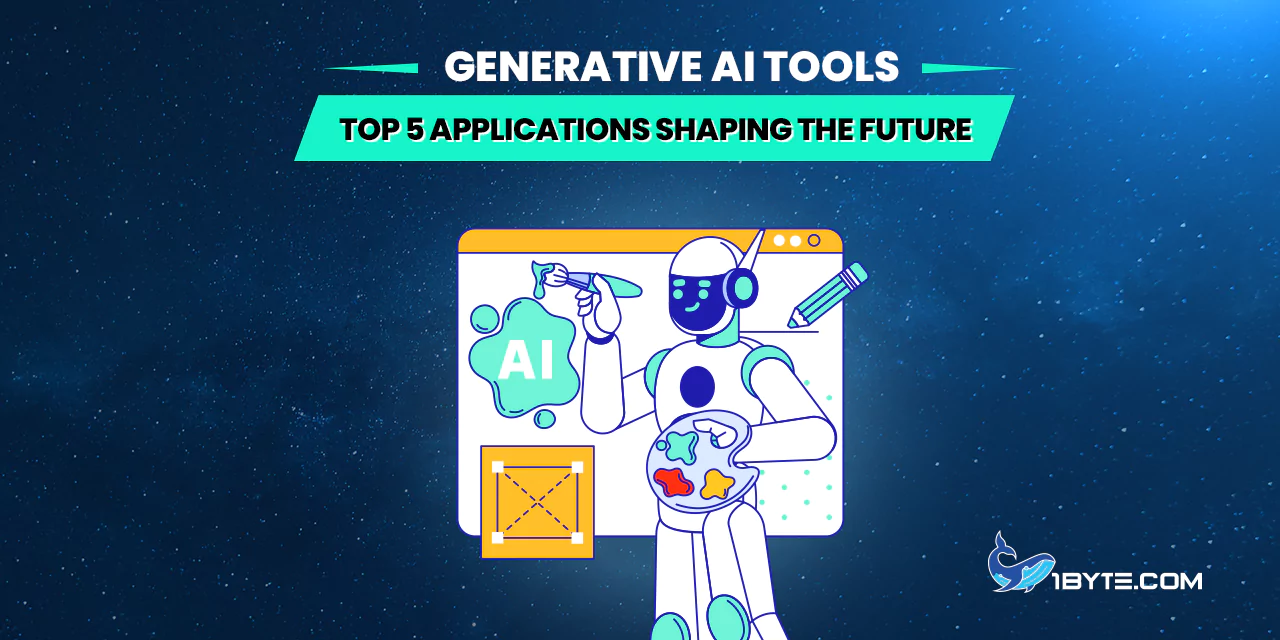Generative AI tools are rapidly transforming various industries, enabling machines to create content and perform tasks that once required human intelligence. By 2024, 65% of organizations have reported already using generative AI on a regular basis, a figure which was considerably higher than previously.
ChatGPT by OpenAI is one of the most notable ones as it has reached a market share of 60.2% by 2024 with even a million users in just five days of the launch. Also, Anthropic’s CEO believes that within the next six months to three months, AI will write 90 percent of the software code only, affirming the swift integration of AI in software development.
The growth in AI in general is reflected in global AI market growth expected to grow 38% in 2025. Driven by the rapid advancement of AI technologies which are now being used across industries like healthcare, finance, and retail and consumed by hundreds of millions of customers, the AI usage surge is now become a necessity.
These tools are set to radically disrupt the way we work, make, and communicate – all thanks to increasing affordability. Read this article from 1Byte to find out more.
An Overview of Generative AI Tools

Generative AI tools are revolutionizing various industries by enabling machines to create content and perform tasks that traditionally required human intelligence. These use algorithms to generate new content such as text, images, code, and so on.
Key Statistics
- Market Growth: The global generative AI market is expected to grow beyond $36 billion by the end of 2024, and the potential is that different industries will rapidly adopt generative AI.
- User Demographics: 65% are Millennials or Gen Z, 72% have jobs for those who use generative AI. It indicates significant demand for generative AI especially from the younger, working population.
- Business Adoption: Nearly 74% of business owners think that AI will help readers get responses from their customers, such as chatbots, and 70% of them will use AI to make content generation much faster.
Top 5 Generative AI Applications
Generative AI tools are revolutionizing various industries by enabling machines to create content and perform tasks that traditionally required human intelligence. Neither has it been used only to make these applications efficient; they are unleashing new possibilities as well in various sectors.
AI-Powered Content Generation
The use of AI to build written material is revolutionizing the way in which companies and people make content. Using more advanced algorithms, these tools craft high quality content very quickly and efficiently. This is transforming the way content is created in different sectors.
AI’s adoption in content creation has become quite a rapid thing. According to a recent survey, 76% of marketers are utilizing generative AI in basic content and copywriting tasks. It is to be noted that this widespread use signals an increasing need for the AI to fill in the content demands.
Furthermore, there is a huge growth in the global AI market. It is estimated to grow at a CAGR of 37.3 % during the forecast period (2022–2030) driven by making generative AI increases. The significance of AI in the different industries has been captured in this article.
Notable AI Content Generation Tools
Several AI tools have emerged as leaders in content generation:
- Jasper: Tailored for businesses, Jasper assists in creating marketing copy, social media posts, and other content forms, enhancing productivity and consistency.
- Anyword: Specializing in advertising and social media content, Anyword generates copy designed to engage audiences effectively.
- Writer: Focused on AI compliance, Writer ensures that generated content aligns with brand guidelines and industry standards.
- Writesonic: Geared towards content marketing, Writesonic aids in crafting articles, blog posts, and other long-form content efficiently.
- HubSpot’s AI Tool: This tool generates unique content ideas tailored to engage audiences and improve search engine rankings.
Benefits and Considerations
Integration of AI powered content generation is truly something that brings you lots of benefits like it is increasing your efficiency, maximizing scalability, and also helps you to tailor content for various audiences. While it’s important for accuracy, creativity and maintaining an appropriate brand voice to keep human oversight.
As AI technology gets more advanced, its presence in content creation is growing, and creators and businesses alike are faced with both new opportunities and new challenges.
Image and Video Creation
Generative AI tools are revolutionizing image and video creation, enabling users to produce high-quality visuals with unprecedented ease. These new technologies are recasting the entertainment, marketing, design industries, among others.

Over $299.2 million was accounted for in the AI image generation market in 2023. It is projected to grow at a compound annual growth rate (CAGR) of 17.4% to reach $917.4 million by 2024. Such a surge is in support of the growing AI integration into creative processes.
Notable AI Image Creation Tools
As for image generation, several AI-powered tools have come up as leaders.
- DALL·E 3 by OpenAI: Recognized as one of the best AI image generators, DALL·E 3 can handle complex queries, offering extensive editing and customization options.
- Midjourney: This tool enables users to generate images from text prompts, facilitating the creation of unique visuals for various applications.
- Adobe Firefly: Integrated into Adobe Creative Cloud, Firefly allows for text-based editing and generation of images, videos, and 3D content.
Advancements in AI Video Creation
Video production is also affected by AI and shares its tools with it, making the creation process simpler and more enriched.
- Runway’s Gen-2: A multimodal AI system capable of generating novel videos from text, images, or video clips, making video creation more accessible.
- Luma’s Dream Machine: This tool uses AI to generate lifelike videos from images or text prompts, enabling quick production of professional-looking clips.
- Synthesia: Allows users to produce AI-generated videos by uploading a short clip, creating numerous video variations in different languages, significantly reducing production time and costs.
Industry Adoption
AI is integrated into creative workflows of major companies:
- Adobe: At the Adobe Summit 2025, the company introduced new video editing tools and APIs for Firefly Services, aiming to enhance productivity in content creation.
- Snapchat: The platform is rolling out AI-powered video lenses, allowing users to integrate AI-generated elements into their videos, enhancing user engagement.
- Tencent: The company released open-source 3D generation tools that convert text and images into 3D visuals, advancing China’s capabilities in generative AI.
These developments highlight the transformative role of generative AI tools in image and video creation, offering innovative solutions that streamline workflows and expand creative possibilities.
Code Generation and Automation
Generative AI tools are transforming software development by automating code generation and enhancing productivity. They are used by developers for writing the code, debugging, and optimizing the performance of the program thus large efficiency gains.

The AI code tools market is experiencing rapid expansion. Valued at $3.97 billion in 2023, it is projected to reach $27.17 billion by 2032, reflecting a compound annual growth rate (CAGR) of 23.8%. This growth underscores the increasing reliance on AI in coding practices.
According to a survey released recently, 76% of the developers are using AI tools or plan on using AI tools in their development process – from 70% compared to the previous year. This is a trend to see the integration of AI with the coding workflow.
Notable AI Code Generation Tools
Several AI-powered tools have emerged as leaders in code generation and automation:
- GitHub Copilot: Integrated within popular code editors, Copilot provides real-time code suggestions and autocompletion, streamlining the coding process. Studies have shown that developers using Copilot are 55% faster in task completion and 88% more productive.
- Tabnine: Utilizing deep learning models, Tabnine offers code completions and predictions, supporting multiple programming languages and enhancing coding efficiency.
- Amazon CodeWhisperer: Designed to assist in code generation, CodeWhisperer provides code recommendations based on natural language prompts, improving developer productivity.
The integration of AI in coding is reshaping the software development landscape. Dario Amodei, CEO of Anthropic, predicts that within the next three to six months, AI will be responsible for writing 90% of software code, underscoring the rapid integration of AI in software development. This shift allows developers to focus more on design and problem-solving tasks, potentially altering traditional coding roles.
In addition, small teams are able to perform processes previously available for larger groups thanks to AI coding tools. It is promoting innovation and allowing startups to go leaner.
But despite the above advantages, there are still obstacles in the way of integrating AI tools into current workflows, but they are beneficial in their own right. To keep the authenticity of AI generated code reliable, organizations should develop and address issues like code quality, security and the human intervention.
In summary, generative AI tools are revolutionizing code generation and automation, offering significant benefits in productivity and efficiency. These tools will play a more and more central role in software development as they develop.
AI-Driven Music and Audio Synthesis
Generative AI tools are transforming the music and audio industry by enabling machines to compose music, generate realistic singing voices, and synthesize unique sounds. These innovations are reconfiguring the way artists, producers, and others work with and otherwise produce and engage with audio content.
With a $2.9 billion valuation, the AI in the music market is to reach a worldwide value in 2042. According to projections, it is predicted to grow to s$38.71 billion by 2033 that indicates a compound annual growth rate (CAGR) of 25.8%. This growth signifies a rise in the number of integration services of AI tech in music production and audio synthesis.
Notable AI Music and Audio Tools
Several AI-powered tools have emerged as leaders in music and audio synthesis:
- Suno AI: Launched in December 2023, Suno AI generates realistic songs by combining vocals and instrumentation based on user-provided text prompts. It has gained attention for its ability to create high-quality audio content efficiently.
- Udio: Released in April 2024, Udio allows users to generate songs using AI, making music creation more accessible to non-musicians. It has been utilized to produce viral content, demonstrating its impact on modern music production.
- ElevenLabs: Recognized for its exceptional quality, ElevenLabs offers AI voice generation that creates realistic voices from scratch or allows users to clone their own voices, delivering professional voiceovers without expensive recording equipment.
Industry Adoption and Innovations
Major companies are integrating AI into their audio workflows:
- Nvidia: Introduced Fugatto, an AI model capable of generating novel sounds and modifying existing audio. This tool can transform a piano melody into a sung line or alter accents and moods in spoken recordings, offering innovative possibilities for audio production.
- Supertone: Backed by HYBE, Supertone uses AI to create digital counterparts for artists and entire AI-based groups, enhancing fan-artist connections by providing multilingual songs. This technology deepens fan engagement by offering personalized experiences.
These developments highlight the transformative role of generative AI tools in music and audio synthesis, offering innovative solutions that streamline workflows and expand creative possibilities.
Synthetic Data for AI Training
Generative AI tools are transforming artificial intelligence by creating synthetic data for model training. To overcome this issue, this approach utilizes data scarcity and boosts the model performance.

There is a fast growing synthetic data generation market. It is projected to grow at a compound annual growth rate (CAGR) of 35.7% during the forecast period from 2024 to 2034 and is valued at $310.5 M in 2024 to reach $6.64 B by 2034. The demand for synthetic data in AI development is soaring, and this surge only serves to illustrate this fact.
By 2024, Gartner predicts that 60 percent of data used for AI and analytics projects will be synthetic. And this is a trend that shows that the industry is starting to accept synthetic data.
Notable Synthetic Data Generation Tools
Several AI-powered tools have emerged as leaders in synthetic data generation:
- MOSTLY AI: Offers AI-powered synthetic data generation with high accuracy, allowing users to create privacy-safe synthetic versions of datasets without coding.
- Synthea: A free, open-source tool designed to create synthetic patient data for healthcare analytics, enabling comprehensive testing and model development.
- K2View: Combines AI- and rules-based generation with intelligent data masking, facilitating quicker and more secure software releases.
Industry Adoption and Innovations
Major companies are integrating synthetic data into their AI workflows:
- NVIDIA: Introduced Cosmos, an AI model family that generates synthetic data to train humanoid robots and self-driving cars, enhancing their ability to navigate complex environments.
- OpenAI: Facing data shortages, OpenAI is exploring the use of AI-created synthetic data to train advanced models, aiming to overcome limitations in available human data.
These developments highlight the transformative role of generative AI tools in creating synthetic data, offering innovative solutions that address data scarcity and enhance AI model training.
Leverage 1Byte’s strong cloud computing expertise to boost your business in a big way
1Byte provides complete domain registration services that include dedicated support staff, educated customer care, reasonable costs, as well as a domain price search tool.
Elevate your online security with 1Byte's SSL Service. Unparalleled protection, seamless integration, and peace of mind for your digital journey.
No matter the cloud server package you pick, you can rely on 1Byte for dependability, privacy, security, and a stress-free experience that is essential for successful businesses.
Choosing us as your shared hosting provider allows you to get excellent value for your money while enjoying the same level of quality and functionality as more expensive options.
Through highly flexible programs, 1Byte's cutting-edge cloud hosting gives great solutions to small and medium-sized businesses faster, more securely, and at reduced costs.
Stay ahead of the competition with 1Byte's innovative WordPress hosting services. Our feature-rich plans and unmatched reliability ensure your website stands out and delivers an unforgettable user experience.
As an official AWS Partner, one of our primary responsibilities is to assist businesses in modernizing their operations and make the most of their journeys to the cloud with AWS.
Conclusion
Generative AI tools are revolutionizing various sectors, offering both opportunities and challenges. They reshape the traditional workflows and the economic landscape by their rapid integration in the industries. The generative AI market is growing globally. Valued at nearly $45 billion in 2023, it is expected to surpass $200 billion by 2030, marking a 361% increase. This surge underscores the escalating demand and investment in AI technologies.
As generative AI tools continue to evolve, their integration into daily operations is set to deepen. Despite the large list of benefits to efficiency and creativity they bring, we must address the meaty challenges of employment, ethics and mental health. A balanced approach towards AI will make it a tool for improvement in the interest of business and the people.

